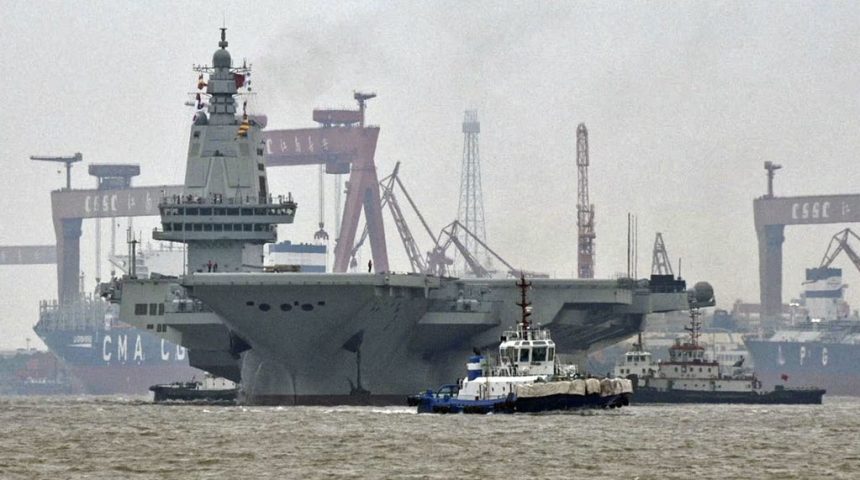China’s first supercarrier, equipped with electromagnetic catapults and arrestor gear, will operate a new carrier air wing which includes the J-35.
The People’s Liberation Army Navy reached a new milestone in the ongoing fleet expansion, with its first supercarrier, Fujian, beginning sea trials after six years of construction works. The aircraft carrier left Jiangnan’s pier, in the Yangtze river’s delta, on April 29, 2024, under its own power and assisted by several tugboats.
After remaining stationary for some time in the area, Fujian moved along the riverfront before heading out to sea. The Chinese Maritime Safety Administration has issued a navigational hazard notice from May 1 to 9 and defined a shipping exclusion zone in the East China Sea off the coast of Shanghai, about 130 km from Jiangnan’s shipyard.
And another nice image of the Fujian moving out to her first sea trial.
(Image via @包容万物恒河水 from Weibo) pic.twitter.com/mvDIAjgBHI
— @Rupprecht_A (@RupprechtDeino) May 1, 2024
“The sea trials will primarily test the reliability and stability of the aircraft carrier’s propulsion and electrical systems,” read an announcement from the state-run Xinhua news agency. Based on what was observed with previous Chinese aircraft carriers, the entire test campaign should last over a year.
CV FUJIAN left the pier to conduct the 1st sea trials this morning. pic.twitter.com/WOCosiXHUM
— dafeng cao (@dafengcao) May 1, 2024
The Fujian aircraft carrier
Fujian, hull number 18, is the third aircraft carrier of the People’s Liberation Army Navy, after Shandong and Liaoning, and the first equipped to perform CATOBAR (catapult-assisted takeoff but arrested landing) operations. It is also China’s first supercarrier, with a displacement of 80,000 tons, and the first fully indigenous design.
The construction started six years ago, when in 2018 the first “superblock” hull module was sighted at Jiangnan. These modules were assembled into larger hull segments throughout the next two years, before being moved to drydock for final assembly. The aircraft carrier was launched on June 17, 2022.
It is *now* that we can confirm CV-18 Fujian has gone on its first sea trial, occurring on 1st May 2024 today. pic.twitter.com/8pmVhitOOv
— Rick Joe (@RickJoe_PLA) May 1, 2024
Naval News was able to deduce Fujian’s approximate dimensions from available imagery. Basic measurements for the hull are a length of approximately 316 metres, a beam across the flight deck of 72 metres average and 76 metres at the widest point. Hull beam at waterline level is around 39 metres.
The carrier appears to be equipped with two aircraft elevators, three catapults and four arrestor wires. Specifically, Fujian is equipped with electromagnetic catapults, which are similar to the electromagnetic aircraft launch system (EMALS) being introduced by the U.S. Navy, according to Chinese media, allowing the carrier to launch heavier aircraft with larger payloads compared to previous Chinese carriers.
离岸后右侧挂RU1(1被舰岛遮挡)“本船正在试航”,左侧即之前的18Y,考虑到辽宁舰访问香港时挂16Y,Y在中国海军特指航母,而不是一般意义上的“本船正在走锚”。 pic.twitter.com/0lj0hdu4ui
— 逆袭 (@horobeyo) May 1, 2024
The island, which houses the bridge, smokestack, AESA radar arrays, sensors and multiple antennas, is located between the two elevators. The propulsion system appears to be made of conventional steam turbines, similarly to previous Chinese carriers, although no details were released about this by Chinese media.
Fujian apparently retained the same defensive system seen on Shandong and Liaoning, made of a combination of HQ-10 short-range surface-to-air missiles and 30 mm multi-barrel close-in weapon systems (CIWS).
Fujian’s carrier air wing
While no official info are available regarding the definitive carrier air wing that will be embarked on Fujian, mockups of the aircraft expected to operate from the carrier were photographed on deck. Among these are the J-35, J-15, JL-10J and KJ-600.
The J-35 is the new stealthy multirole fighter being developed for the PLAN and is expected to be first embarked on Fujian. The J-35 was developed from the FC-31 and is a bit smaller and lighter than the J-15, with many similarities with the F-35C.
China has also been working for some time on the J-15B, a variant of the J-15 specifically equipped for CATOBAR operations. The current J-15 is a Chinese variant of the Su-33 Flanker, which is only equipped for STOBAR (short takeoff but arrested landing) operations on carriers equipped with a ski jump. Similarly to the J-15, the J-15B is expected to be the primary combat aircraft on the carrier.
16/17/18舰岛视角 pic.twitter.com/K3zpw8cgnf
— 逆袭 (@horobeyo) May 1, 2024
Another Flanker derivative, the J-15D, is also expected to be among the embarked aircraft. The J-15D is a twin-seater electronic warfare variant which appears to have been designed to perform a role similar to the U.S.-made EA-18G Growler.
An important asset will be the KJ-600 airborne early warning and control (AEW&C) aircraft, the Chinese equivalent of the U.S.-made E-2 Hawkeye. Like the J-35, it shares many similarities with its U.S. counterpart and it’s being flight tested since 2020.
The last but not the least is the JL-10J, the navalized variant of the JL-10 advanced trainer. A rumor about this variant circulated for years, but now a mockup was visible on the aircraft carrier.
CV FUJIAN has been moved out the fitting out basin and berthed at the river side pier, reportedly, 1st sea trials would start tomorrow. pic.twitter.com/YJ8x4bvTfK
— dafeng cao (@dafengcao) April 30, 2024
Similarly to the two previous carriers, Fujian could include the Z-8/18 family of utility and ASW-helicopters. Later, thy will probably be likely joined by both utility and ASW-variants of the newer Z-20 medium helicopter.









